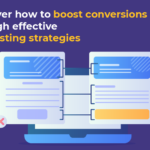A/B testing is one of the most effective ways to improve your website’s conversion rates by directly comparing two versions of a webpage or an element, such as a headline, button, or layout. By testing different versions, you gain insight into what resonates best with your audience, helping you make data-driven decisions that can significantly increase engagement and conversions.
Why A/B Testing Matters
A/B testing helps to optimize every aspect of the user experience (UX) on your website. By identifying the specific elements that drive user behavior, you can increase the likelihood of conversions — whether that’s clicking a CTA, signing up for a newsletter, or completing a purchase. Regular A/B testing allows you to continuously refine your site’s performance, boosting overall ROI and supporting long-term growth.
Steps to Effective A/B Testing
- Define Clear Goals
Start by identifying specific conversion metrics you want to improve, such as click-through rates, sign-ups, or purchases. - Choose Elements to Test
Test elements that are likely to impact user decisions. Popular test items include:- Headlines and Subheadlines
- Call-to-Action (CTA) Buttons
- Images and Visuals
- Layout and Navigation
- Create Hypotheses
For each element, form a hypothesis based on data or user feedback. For example, “Changing the CTA button color from blue to red will increase click-through rates.” - Run the Test
Use tools like Google Optimize, Optimizely, or VWO to set up and monitor the test. Split your audience evenly and let the test run long enough to gather sufficient data, ensuring statistical significance. - Analyze Results
Look at the data to see which version performed better. Check metrics like bounce rate, time on page, and conversion rate. - Implement Changes
If one variant significantly outperforms the other, implement it site-wide and continue testing other elements for ongoing optimization.
Best Practices for A/B Testing Success
- Test One Variable at a Time: Isolate each variable to understand its specific impact on conversion rates.
- Prioritize High-Traffic Pages: Focus on pages with high traffic and engagement for faster, more accurate results.
- Keep Tests Running Long Enough: Running tests too briefly can lead to inaccurate conclusions. Aim for at least two weeks.
Common A/B Testing Mistakes to Avoid
- Changing Multiple Elements at Once: Testing too many elements at once can make it difficult to pinpoint which change drove the result.
- Running Tests Without Enough Traffic: Low traffic can lead to inconclusive results, so focus on pages with sufficient daily visitors.
- Ignoring User Segmentation: Different segments (new vs. returning users) may respond differently to changes, so consider testing segments individually.
Conclusion
A/B testing is a powerful tool to increase conversion rates by understanding what works best for your audience. With well-defined goals, clear hypotheses, and proper analysis, A/B testing can significantly impact your website’s performance. Commit to continuous testing to keep improving your site and ultimately drive more conversions.







